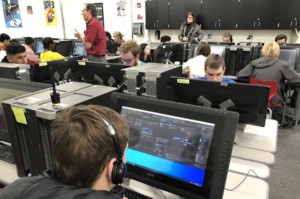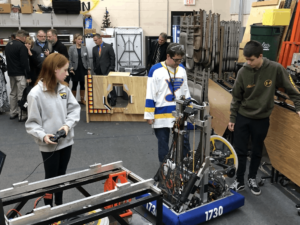Richard Boyd: Chief Architect, Virtual World Labs – Lockheed Martin
Blended learning has started to become popular in ed reform discussions. Can you describe the features that make it a beneficial choice for teachers and students?
In my mind “blended learning” is ideally the right medium for the right lesson for the right learner at the right moment. When I hear people talking about blended learning it makes me think about the initial use of “multimedia” as a term and how it rapidly came to signify nothing.
For me, the best blended learning is a simulation, where all media are present at once, including live instructors. And immersive simulations are a medium that can take a student to inaccessible places, like inside the human body, or inside a molecule, or into the past or the future or to the surface of Mars. I think a shorter path to mastery is simply relevant practice with feedback. And people learn best when they learn by doing, by experiencing the content, whatever it happens to be. The best way to learn a foreign language, for example, is the way wealthy people did it in the 1800s- immerse oneself in the culture and language of Italy and emerge fluent, or nearly so, through immersion experiences.
Where does your interest in data and online assessment come from? A little of your background before you got into stuff at Lockheed.
My entire career has been about helping poor dumb humans (with our 200Hz brain synapses) learn to prepare to operate in and understand an increasingly complex world by harnessing technology. I believe this is increasingly becoming an existential issue. But, I also believe that we will have fully realized the full benefit of our rapidly accelerating technology capability only when it becomes completely transparent to us. In other words, performance is about situational awareness and having the right information at the right time to perform the optimal action. We go to classes, read books, engage in multimedia instruction and climb into simulators and simulations because we want to perform optimally. It is a means to an end. If all of this information were available to us at the right moment, we could perform better.
I have spent 20 years working with interactive 3D graphics as a medium. The initial problem set where I focused outside of just pure entertainment was on visualization. 75% of all humans can not look at 2D information like a picture, sketch or blueprint, and imagine what the resulting 3D experience of the content would be in real space. By harnessing interactive 3D media we were able to bridge that gap and provide a way for architects, engineers and film directors to communicate their vision in ways they never could before.
In the mid nineties we took our rudimentary real-time 3D graphics into a 3rd grade class room in North Carolina. We separated the class into two groups. One group learned the concept of a water molecule from a teacher using a chalkboard and lecture. The other group was able to immersively experience the concept of a water molecule by taking the mouse and flying through and around the oxygen and hydrogen atoms and into the nucleus to see all of the elements. There was no game element; it was simple, first person simulation. A week later the kids were tested and the group who experienced the abstract concept of the molecule scored markedly higher than the control group. This got me thinking about other areas where we could harness what we know about how immersive experience improves memory.
In what ways does online and visual software help in the organizing of information?
Computers are very powerful. But we still use flat screens to view information. Overlapping windows hide others and somewhat limit our ability to see complex connections. For some time I have promoted the idea of moving to a 3D interface where information is grouped by relation in 3D space and moves around an information landscape (first mentioned by Edward Tufte) or information sea.
In the age of television we found ourselves 10 feet from a portal into a dizzying amount of new information. It was information that was distilled and programmed by a few and broadcast to many, but it was breathtaking, nonetheless. And it changed the way the baby boomer generation learned, socialized and made sense of the World. In the early nineties increasing numbers of humans began to have access to the Internet, placing us one foot from a multitude of information published by many for many with few filters, if any. And we find ourselves now, in 2010, on the edge of a new era, when humans will no longer be outside the fishbowl looking in at information, but inside looking around and swimming in seas of information.
- Newspapers, books, magazines: one way, passive text, image
- Telephone: two way, active voice
- Radio: one way, passive voice
- Fax: two way, one to one or one to many, passive text, image
- Television one to many, one way, passive, linear voice, image, sound, text
- Internet: two way, passive and active, linear or non-linear voice, image, sound, text
- Metaverse: multi-way collaborative, active or passive, linear or non-linear voice, image, sound, text, 3D interactive objects and environments, avatar representations of humans or AI agents.
Games are… the most ancient and time honored vehicle for education. They are the original educational technology, the natural one, having received the seal of approval of natural selection. We don’t see mother lions lecturing cubs at the chalkboard; we don’t see senior lions writing their memoirs for posterity. In light of this, the question, ‘Can games have educational value?’ becomes absurd. It is not games but schools that are the newfangled notion, the untested fad, the violator of tradition. Game-playing is a vital educational function for any creature capable of learning. ~ Chris Crawford in The Art of Computer Game Design
What was the purpose of your work at Lockheed Martin? Are you still doing that, and what elements of that practice might translate well into education practice at the public school level?
At LM I have organized an informal group of engineers and technologists across all of the business units to focus on improving human performance using game technology. The group is called Virtual world Labs, and serves as a rallying point internally, but also a lightning rod for any customers who are exploring the application of interactive 3D gaming to a problem.
One highly relevant program that is driving our approach to education is the amazing lessons we have learned from a seemingly unrelated endeavor in the United Kingdom. The UK ministry of defense has tapped Lockheed Martin to train all of its aircrew for the next 25 years. It is one of the most amazing contract I have seen in my career. It is set up the way all human endeavors should be, with perfectly aligned incentives. Here is how it works:
The UK provides us with candidates they deem to be qualified to become jet fighter pilots, r helicopter pilots or cargo plane pilots or air crew aboard those aircraft. We are completely responsible for their training. We must determine how much time should be spent in a real aircraft, how much time in a simulator, how much time with interactive multimedia instruction, how much time with class room instruction and how much time in self study. Lockheed Martin is only paid when a qualified air crew member is produced. We have every incentive in the world to determine the shortest path to mastery. The results have been what you might predict. More pilots trained at a lower cost in a shorter amount of time than anyone predicted.
Armed with this knowledge of how different kinds of students respond to different training media for different kinds of tasks compels us to see if we can apply this knowledge to improving our lagging education system. What if we could achieve 12th grade competency in the U.S. in only ten grades? Or nine? Perhaps we move students into the work force early, or use the extra time for more mastery; or community service. These are the ideas that motivate me to continue to press these simulation capabilities forward in an accelerating information age.





Richard
Looks like the table in the middle lost formatting